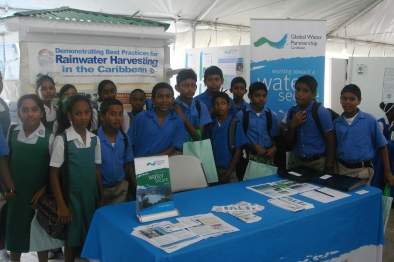Since the development of the model, GWP-C has been able to use it as an educational tool in the region and at a number of public exhibitions in rural communities. One such event was the Tabaquite Community Science Week held in Trinidad on February 6th - 11th, 2012. The Community Science Week is an initiative of GWP-C’s partner, the National Institute of Higher Education Research, Science and Technology (NIHERST) aimed at promoting science education in rural communities in a fun, creative and meaningful way.
Taking into account the expected target groups that would visit the Community Science Week, apart from displaying its RWH Model and using it has a tool to share information on the benefits of rainwater harvesting, GWP-C wanted to ensure that it developed educational material for a wide cross-section of stakeholders. These stakeholders included:
- Students (primary, secondary and tertiary level)
- Teachers (at the primary and secondary school levels)
- Representatives from government ministries/agencies
- Representatives from non-governmental organisations (NGOs)
- Members from community groups
- Residents from Tabaquite and surrounding areas
With the use of its RWH model, GWP-C was able to explain to students and visitors how a RWH system works in an interactive way. While the water in the model was channeled through the rainwater harvesting system, students, teachers and other visitors were asked various questions related to the processes taking place.
When the water in the system fell on the roof on to the guttering, students were able to identify reasons why the initial run-off would be contaminated. What is somewhat unique to the GWP-C rainwater harvesting model that is not common to a typical RWH system is the first-flush diverter. The first-flush diverter is part of the downpipe configured to remove the initial wash off the roof so it does not enter the water tank. This allows the first flow of water containing roof debris to settle at the bottom of the downpipe with the cleaner water settling on top, allowing clean water to enter the tank. After explanations of the first-flush device, students and other visitors were able to explain the process in the device themselves and explain its benefit on a RWH system.
Flyers on the various components of the RWH system were shared with students and other visitors, particularly on the first-flush device and its role in protecting water quality. A question and answer game on the uses of rainwater was played with many of the primary school students at the Science Week; students that answered correctly were given stickers on ways rainwater can be used and ways to conserve water.

Some of the students that visited the GWP-C booth to learn about rainwater harvesting and water conservation.
Teachers that visited the GWP-C display at the Science Week were all given a GWP-C Water Education
Package which included water conservation tips; water education activities for the classroom; and online water education resources. Other material shared at the event included GWP-C flyers, RWH posters, RWH bookmarks and water conservation bookmarks.
The Community Science Week afforded GWP-C the opportunity to share knowledge on rainwater harvesting and water conservation with more than 800 students, over 40 teachers and more than 200 other visitors over the week-long period.
